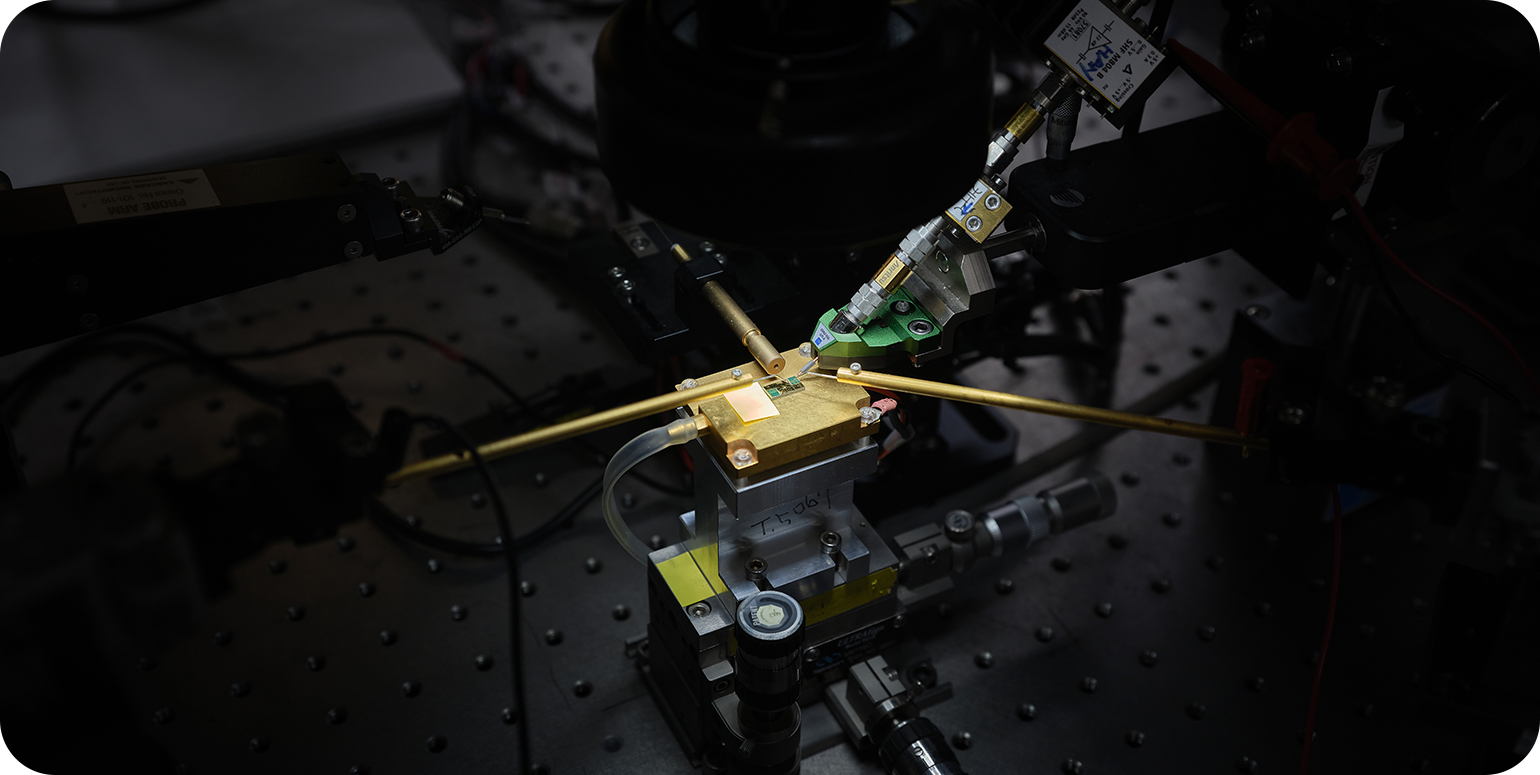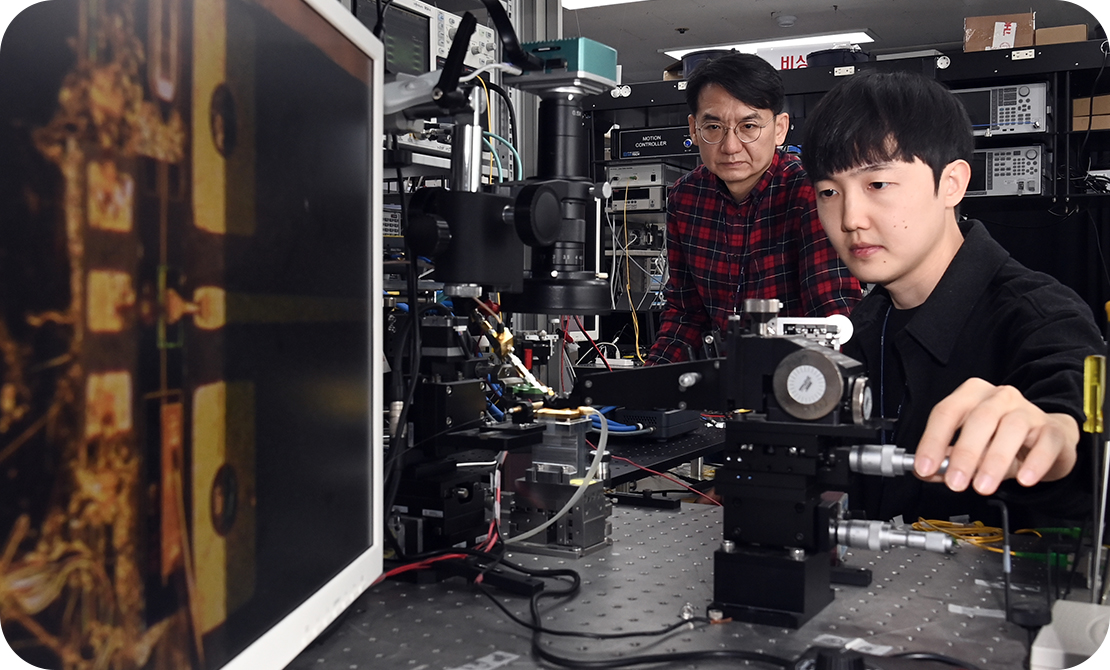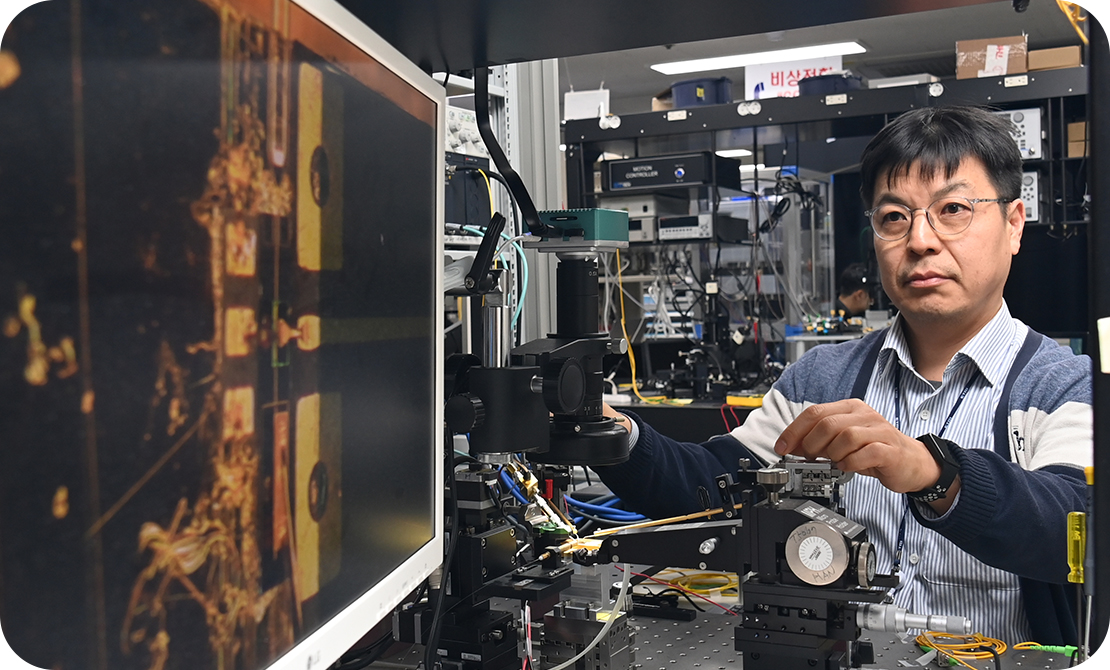ETRI Develops Revolutionary Light Source Device to Address Data Explosion
- Innovations include a 224-Gbps light source featuring the monilithic integration of a photonic mode converter and a monitoring photodetector.
- Achieved a doubling in modulation bandwidth and data processing capacity per channel compared to existing solutions.
- Facilitates the transmission of 5.6 full HD movies per second over datacenter and 5G networks, significantly contributing to the cost reduction of optical modules.

ETRI’s researchers have pioneered the development of light source* devices that can be utilized in mega/hyper datacenters and 5G/6G mobile communication base stations. The technology innovated by the research team can transmit full HD movies of 5 GB size at a rate of 5.6** per second.
Electronics and Telecommunications Research Institute (ETRI) announced the independent development of an electro-absorption modulated laser (EML) light source*** device technology. This technology is capable of transmitting 224 Gbps optical signals per channel in datacenters’ internal networks and is remarkably compact, measuring less than a millimeter (0.2 mm x 0.85 mm) in size.
The research team domestically developed the EML light source device, which is integrated with a photonic mode converter**** and a monitoring photodetector*****, through indigenous technology from the design to the manufacturing stages.
Once commercialized, the developed light source device will be embedded in the tower racks inside large datacenters. These light source devices will be applied to the transmission part of optical transceivers (optical transmitter and receiver modules), essentially being inserted into the line cards within the tower racks. Typically, 32 optical transceivers with 224 Gbps x 8 channels each constitute a single linecard, with multiple linecards being mounted on the tower racks.
The researchers emphasized the significance of moving beyond module development to chip-level development, which is a core foundational technology. By developing key technologies for the light source chip, they expect to lead the global market for optical communications.
With the increasing data usage in virtual reality (VR), augmented reality (AR), Over The Top (OTT), artificial intelligence (AI), etc., there was a need for ultra-fast light source technology for transmission in intra-datacenters. This technology would enable larger modulation bandwidths and data processing capacities, making it possible to implement more substantial and cost-effective optical modules.
* Light Source Device (Laser Diode): A device that converts electrical signals into optical signals, fabricated through compound semiconductor processes.
** 5 GB (Giga bytes) = 40 Gbit: With a speed of 200 Gbps, it is possible to transmit 5 movies per second.
*** EML (Electro-absorption Modulated Laser): A compound semiconductor optical source device that modulates optical signals through an electro-absorption effect.
**** SSC (Spot-Size Converter): A mode-size converter integrated with an light source device to increase the optical coupling efficiency with planar lightwave circuits.
***** MPD (Monitoring Photo-Diode): A photodetector that allows real-time monitoring of the optical output intensity of the light source device.

Traditional optical transceivers* used inside intra-datacenters could transmit up to 100 Gbps optical signals per channel with electro-absorption modulated laser (EML) light source devices.
ETRI has fabricated the world’s premier EML light source device, which can transmit 224 Gbps optical signals per channel. This device doubles the modulation bandwidth and data processing capacity.
Moreover, for the first time globally, a photonic mode converter to enhance optical coupling efficiency and a photodetector for real-time monitoring of the light output intensity of the light source device have been uniquely integrated into the 224 Gbps EML light source device.
Through the integration of a mode converter, the optical coupling efficiency has been significantly enhanced, elevating the coupling efficiency with optical waveguides** from the existing 50% to 85%. This advancement also facilitates a reduction in energy/power consumption in optical transceivers.
Furthermore, the integration of a photodetector for monitoring optical output intensity has enabled significant cost savings in packaging for the fabrication of single-channel optical modules, as well as 800-Gbps/1.6-Tbps class optical modules, compared to the conventional structure utilizing separate photodetectors.
The research team developed an electro-absorption modulated laser (EML) device capable of operating at 224 Gbps, showcasing a world-leading performance with a modulation bandwidth exceeding 70 GHz at 70°C. This device demonstrates exceptional performance, enabling 224-Gbps transmission of optical signals over 2 km even at 70°C.
The 224-Gbps class EML device is currently being realized by only a few companies worldwide. The development of this technology, according to the research team, will reduce reliance on foreign imports in the future.
* Optical Transceiver: An unit that transmits and receives optical signals converted from electrical signals.
** Waveguide: A pathway for light. Connects two optical cables to facilitate the transmission of optical signals.

Additionally, the integration of the photonic mode converter and the monitoring photodetector is anticipated to contribute to the technological competitiveness and cost-effectiveness of 800-Gbps/1.6-Tbps optical modules.
ETRI announced that this research achievement was made possible due to their pioneering work in the laser diode technology for creating light sources and their possession of core source technologies in compound semiconductor optical devices, accumulated in their research and development foundry.
Dr. Yong-soon Baek, senior vice president of Terrestrial & Non-Terrestrial Integrated Telecommunications Research Laboratory at ETRI, commented, “We have contributed to securing the competitiveness of the domestic optical device and component industry by becoming the first global pioneer to develop key technologies applicable to the rapidly evolving datacenter and 5G/6G markets.”
Dr. Young-Tak Han, the principal researcher and project leader at ETRI’s Optical Communication Components Research Section, remarked, “For compound semiconductor optical devices, which are highly sensitive to processing variables, the most critical factors are securing core technologies and ensuring stable foundry operations. We have managed to address these issues by developing key technologies.”
The research team has filed for both domestic and international patents based on the developed light source technology. They are also planning to transfer this technology to domestic optical component companies, enabling them to compete with global companies in the datacenter and 5G/6G markets.
According to LightCounting, a market research firm, the global market size for optical transceivers is projected to grow more than threefold, from $6 billion in 2019 to $18 billion by 2026.
Additionally, the ETRI research team presented this technology at OFC* 2023, the largest optical communication conference globally, held in San Diego, USA, in FEBRUARY of the previous year. The technology was highly acclaimed following its publication in the IEEE JLT**, a prestigious international SCI journal in the field of optical communications.
This achievement was made possible through a project sponsored by the Ministry of Science and ICT, focused on the development of optical component technology for 1.6-Tbps optical transceivers for Intra-DC communications.
* OFC (Optical Fiber Communication and Exposition): The largest optical communication conference in the world, organized annually in the USA by IEEE and The Optical Society (OSA). Last year, it saw a participation of 14,500 individuals.
** IEEE JLT (Journal of Lightwave Technology): A prestigious international SCI journal in the field of optical communications, managed by IEEE, with a citation index of 4.7.

Dr. Young-Tak Han, Principal Researcher
Optical Communication Components Research Section
(+82-42-860-5067, frenclin@etri.re.kr)
 Previous
Previous